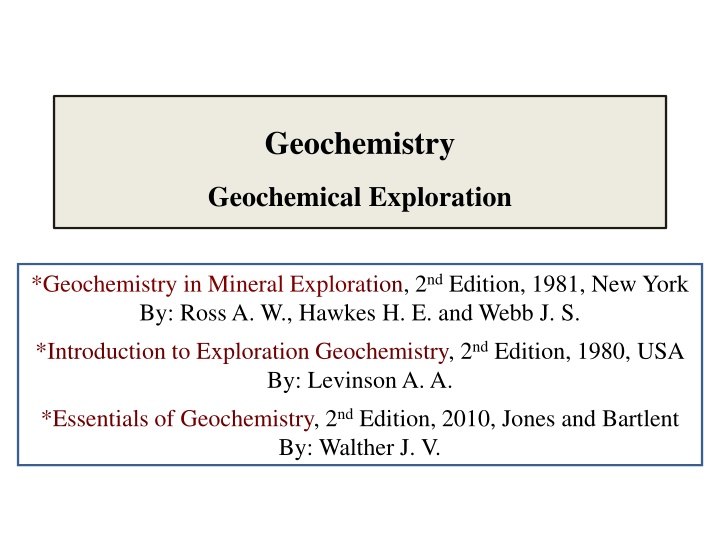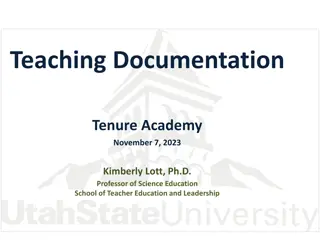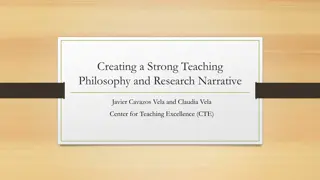
Geochemistry in Mineral Exploration and Anomalies
Explore the principles of geochemistry in mineral exploration, including geochemical environments, dispersion, mobility, and the identification of anomalies in ore deposits. Learn about the geochemical cycle and the importance of determining elemental abundance for solving human needs.
Download Presentation

Please find below an Image/Link to download the presentation.
The content on the website is provided AS IS for your information and personal use only. It may not be sold, licensed, or shared on other websites without obtaining consent from the author. If you encounter any issues during the download, it is possible that the publisher has removed the file from their server.
You are allowed to download the files provided on this website for personal or commercial use, subject to the condition that they are used lawfully. All files are the property of their respective owners.
The content on the website is provided AS IS for your information and personal use only. It may not be sold, licensed, or shared on other websites without obtaining consent from the author.
E N D
Presentation Transcript
Geochemistry Geochemical Exploration *Geochemistry in Mineral Exploration, 2nd Edition, 1981, New York By: Ross A. W., Hawkes H. E. and Webb J. S. *Introduction to Exploration Geochemistry, 2nd Edition, 1980, USA By: Levinson A. A. *Essentials of Geochemistry, 2nd Edition, 2010, Jones and Bartlent By: Walther J. V.
Week (1): Geochemistry in mineral exploration - geochemical environments, dispersion and mobility. Week (2): Geochemical reactions dispersion of elements under deep- seated conditions. Week (3): Association of elements mobility under surficial conditions. Week (4): Epigenetic anomalies in bedrocks. Week (5): Mechanical and biological dispersion in the surficial environment. Week (6): Surficial dispersion patterns soil formation. Week (7): First midterm exam. Week (8): Anomalies in residual and transported overburden. Week (9): Anomalies in natural waters. Week (10): Anomalies in drainage sediments geochemical drainage surveys. Week (11): Vegetations surveys. Week (12): Volatiles and airborne particulates. Week (13): Geochemical thermodynamics: fundamental principles and phase equilibria. Week (14): Second midterm exam. ??
Geochemistry is concerned with: 1. The determination of the relative and absolute abundance of the elements in the earth. 2. The study of the distribution and migration of the individual elements in the various parts of the earth with the object of discovering principles governing this distribution and migration. 3. The application of geochemical principles and information in solving human needs.
The object of geochemistry is to define a geochemical anomaly which distinguishes an ore deposit from background and insignificant mineralization.
Geological and geochemical processes fall into two groups, those that take place at or near to the Earth's surface (surface processes) and those that take place at depth within the Earth (internal processes). Pressure, temperature, and the availability of the most abundant chemical components are the parameters of the geochemical environment that determine which mineral phases are stable.
Geochemical Cycle Geologically and geochemically the Earth constitutes a dynamic system consisting of two major environments: Deep seated (Primary) & Surficial (Secondary) They have gross differences in pressure, temperature and chemistry, which can be represented by the: Geochemical Cycle
The primary (deep-seated) environment extends downward from the lower levels of circulating meteoric water to the deepest level of the crust and may extend into the mantle. It is an environment of high T and P, restricted circulation of fluids, and relatively low free-O2 content.
The secondary (surficial) environment is the environment of weathering, erosion, and sedimentation at the surface of the Earth. It is characterized by low -T, nearly constant low pressure, free movement of solutions, and abundant free oxygen, water, and carbon dioxide.
Elements Associate with certain phases: Siderophile (Fe) Chalcophile (S) Lithophile (Si) Atmophile (gas) Biophile (organic) Distributions in the natural environment are influenced by an element s fundamental chemical characteristics.
Dissolved oxygen and hydrogen sulfide species are very useful because: 1. They are very strongly tied to redox reactions. 2. Their concentrations have very major effects on organisms. 3. They exert a major amount of control on the formation of authigenic minerals. 4. They cannot coexist. 5. Bacteria divide neatly into aerobes and anaerobes.
In Oxic Environment 15O2(aq) + 4FeS2+ 8H2O 2Fe2O3+ 8SO42 + 16H+ O2(aq) + 4FeCO3 2Fe2O3+ 4CO2 O2(aq) + MnS MnO2+ S Oxygen + Sulfides CO2 + SO42 + Metal oxides
For an Anoxic-sulfidic Environment 3H2S (aq) + S + Fe2O3 2FeS2+ 3 H2O H2S (aq) + S + FeCO3 FeS2+ CO2+ H2O 2H2S (aq) + MnO2 MnS + S + 2H2O H2S (aq) + MnO2+ CO2 MnCO3+ S + H2O H2S + Oxides Sulfides Carbonates
Consider a water-sediment interface at pH 7. *If there is not much sulfur present, then Fe2+ predominates at -----?---- Eh. (high or low) *If there are free Fe2+ and Mn2+ in the pore water, then the system is -----?---- (anoxic or oxic).
Geochemical / *Background Normal element abundance level in unmineralized earth material which usually is a range rather then an absolute value. ---------- Any departure from the normal range, positive or negative, is viewed as *anomalous. ---------- *Thresholds
*Target and *Pathfinder Elements (Indicator) Use is frequently made of target elements-Indicator(i.e. Au). In some instances these elements may not be particularly effective. In these cases attention is directed to pathfinder elements (As, Hg, Sb) which may not be the target metal but have geochemically useful features (immobility, mobility, easier or cheaper analysis, better detection limits, etc).
*Geochemical dispersion The process, in which atoms and particles move to new locations and geochemical environments, is called geochemical dispersion. Dispersion pattern Matrix Mobile phase Immobile phase Transport Environment of deposition Environment of mobilization
Dispersion may be the effect of exclusively mechanical agencies, such as: the injection of magma or the movement of surficial material by glacial action






















